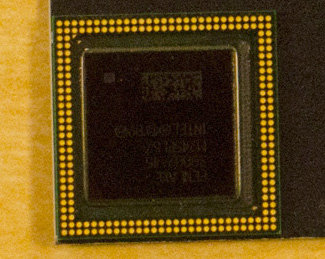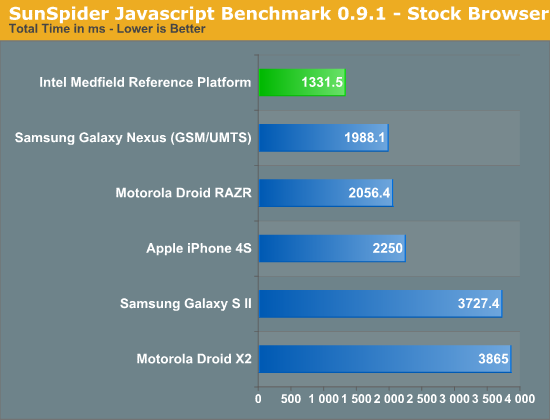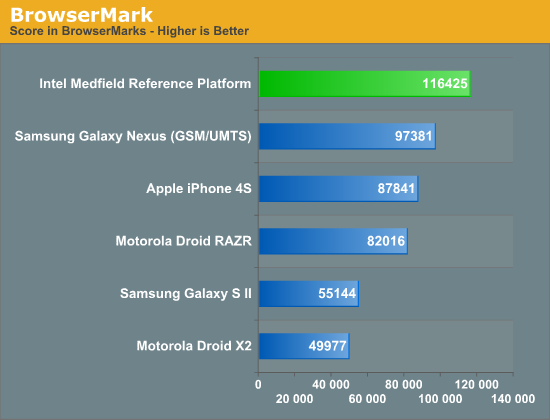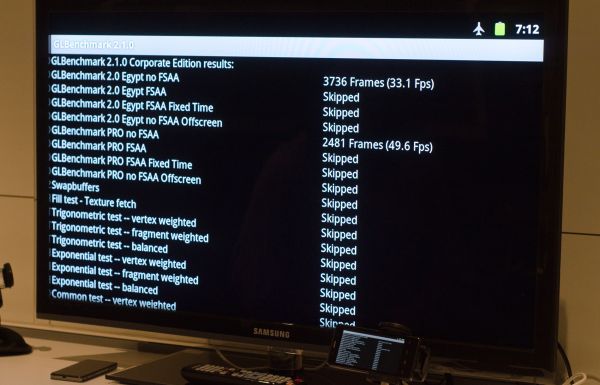Intel's Medfield & Atom Z2460 Arrive for Smartphones: It's Finally Here
by Anand Lal Shimpi on January 10, 2012 8:00 PM ESTIt's here. Intel's first smartphone SoC that you'll actually be able to buy in a device before the end of the year. The platform is called Medfield and Paul Otellini just announced its first device partners.
Medfield starts out as a bonafide mobile SoC. Whereas Moorestown was a "two-chip" solution, Medfield is just one - the Penwell SoC:

The SoC is only available in a PoP (Package on Package) configuration measuring 12mm x 12mm. Intel wouldn't give out a die size but it did show me a Penwell sample without the stacked DRAM:

Since I know the measurements of the package I could estimate the dimensions of the silicon itself. My math worked out to be around 62mm^2. That's larger than a Tegra 2-class SoC, but smaller than Tegra 3 or Apple's A5. The diagram of its high level architecture above helps explain why.
There's only a single version of Medfield being announced today: the Intel Atom Z2460. The Z2460 features a single Atom core with a 512KB L2 cache, a PowerVR SGX 540 GPU and a dual-channel LPDDR2 memory interface. In a world where talking about four Cortex A9s and PowerVR SGX 544MP2s isn't uncommon, Medfield starts out almost sounding a bit...tame. But then you see its performance:

Although running what appears to be a stock Gingerbread browser, Intel's Medfield reference platform posts SunSpider performance better than any other smartphone we've tested - including the Galaxy Nexus running Ice Cream Sandwich. Intel promises that Medfield's performance will scale on ICS as well - the gap should be maintained. We've seen high results from reference designs in the past, but the Medfield platform is a little different as you'll soon see - it's a complete smartphone design that should be representative of handsets that hit the market later this year.
Medfield isn't a one trick pony either, performance is similarly dominating under BrowserMark:

These are tablet-like scores. Here the Galaxy Nexus running ICS comes close, but once again Intel expects that on the same OS Medfield should be faster than any of the currently available SoCs.
I asked Intel where its SunSpider and BrowserMark performance advantages came from, especially considering we've typically only seen huge gains with new browsers and not new SoCs. Their response pointed to a bunch of factors, but one stand out issue was the A9 has a great execution core but seems to be more limited on the memory interface. Atom can support far more outstanding misses in L2 than the Cortex A9, which chokes bandwidth to the processor for anything not already in the L2 cache. This may be one of the reasons why we've never been able to get really high bandwidth numbers out of A9 based SoCs. It's probably safe to assume that things will be different with the Cortex A15, but for now it's little things like this that give Medfield a performance advantage.
GPU performance is understandably not as impressive. We couldn't get offscreen numbers of GLBenchmark 2.1 but we did get results at the device's native resolution (1024 x 600):
3D performance is better than the OMAP 4460 due to Medfield's 400MHz GPU clock compared to ~300MHz in most OMAP4 devices.
Performance without power considerations is meaningless, especially in the smartphone world. Luckily for Intel, Medfield seems very competitive there as well. Intel provided some power and performance data for Medfield based on its reference platform. I still haven't been able to verify any of this for myself, but I was able to see some power tests run in person on the reference platform and competitive devices.
The Intel provided values are pretty astonishing . Sub 20mW idle, sub 750mW during a call on 3G and although not pictured here, Intel's internal data suggests ~1W power consumption while browsing the web compared to ~1.3W on the iPhone 4S and Galaxy S 2. I've done my own measurements on 4S web browsing and came up with a very similar value.
| Intel Measured Smartphone Power Consumption (Identical Display Brightness) | ||||||
| Standby (3G) | Talk (3G) | Browsing (3G) | Video Playback 720p | |||
| Apple iPhone 4S | ~38mW | ~800mW | ~1.3W | ~500mW | ||
| Intel Medfield Reference | ~18mW | ~700mW | ~1.0W | ~850mW | ||
| Samsung Galaxy S II | ~19mW | ~675mW | ~1.2W | ~650mW | ||
The performance and power data both look great for Medfield. You would think that this data, assuming there's nothing fundamentally wrong, would be enough to convince a handset maker to actually give Intel a shot. You'd be right.
In addition to disclosing Medfield performance data, Intel is also announcing partnerships with both Motorola and Lenovo. The former is a broad, multi-year agreement stating that Motorola plans on creating many devices based on Intel silicon - the first of which will be a smartphone due out before the end of the year. Tablets will follow at some point as well.
Lenovo on the other hand will actually be taking and tweaking Intel's own Medfield reference platform, and releasing it in China in Q2.
All of this is exactly what Intel needed: a start.











164 Comments
View All Comments
french toast - Thursday, January 12, 2012 - link
Im sorry, although this isnt an area that i have a huge amount of knowlege on, i can say with some certainty that both Qualcomm and ST-E will have on die baseband shipping this year on 28nm, In qualcomms case the s4 processor that is being demoed with the Asus idea pad has one in.I can also say it has 2 main advantages that i know of (and likely many more that i dont)
1) When put on die and using the same process as in qualcomm and ST-E case it vastly improves power effiecency, a big problem with currant 4g.
2) As most of the components are included on die that you have mentioned, that means more space out side of the die, less hastle for the manufacturers and more space inside the device/phone for things like battery/or smaller device.
Regards to Apple, apple bought PA semi, back in 2007/08 and use it to design its A-series chips, whilst it hasn't used a complete custom licence, they have done some soft optimisations, im not privvy to what they are.
Samsung also acquired intrinsity around the same time, and used their custom logic to some minor power improvements to the cortex core..first seen on the hummingbird..as Apple uses samsung to manufacture there chips, you can bet some of that is licenced too.
Qualcomm ,nvidia (not tegra)and Marvel also have full custom license.
aury - Wednesday, January 11, 2012 - link
"We did manage to run SunSpider on the K800 though, which yielded a score of 1,971 -- just a hair faster than the 1,985 that we saw on the Galaxy Nexus."So either your test is off by about 600 points, or Engadget is blind.
Anand Lal Shimpi - Wednesday, January 11, 2012 - link
I haven't played with the K800 that was being shown off but I am not familiar with the state of Lenovo's Android skin at this point, nor the details of how SunSpider was run. Our SunSpider numbers were run on the Medfield reference design which is what the K800 should be based on though.I'll try and do some digging.
Take care,
Anand
paul878 - Wednesday, January 11, 2012 - link
Who is going to hurt more?Intel entering into the Mobile Space or Arm entering the PC Space?
tipoo - Wednesday, January 11, 2012 - link
Well, Intel has plenty of padding to live on should things go sour. Plus they have compatibility on their side. I'd guess Intel will be fine no matter where things go, ARM now has the pressure on to be competitive.name99 - Wednesday, January 11, 2012 - link
"but one stand out issue was the A9 has a great execution core but seems to be more limited on the memory interface. Atom can support far more outstanding misses in L2 than the Cortex A9, which chokes bandwidth to the processor for anything not already in the L2 cache."It will be interesting to see if ARM take this seriously. Memory performance was THE downfall of PPC. It seems that companies and engineers think connecting to memory is not sexy compared to the core CPU; and I'd love to think that ARM are beyond this sort of childishness, but I honestly don't know.
guilmon19 - Wednesday, January 11, 2012 - link
ARM's A15 platform was also designed with servers in mind, and servers address and use the RAM alot more then basic applications so i think they'll, hopefully, have that fixed by A15IceDread - Wednesday, January 11, 2012 - link
I've always said that Intel would gain on ARM and eventually pass ARM. While I believed it would take a year more or two before they were this close on ARM, I'm still right :pThis will be interesting to follow, hopefully Amd gets their thump out and also does something on this market and then we have both Intel and Amd competing with cpu and gpu power for mobile devices.
varunkrish - Wednesday, January 11, 2012 - link
I believe Anand Chandrasekher who was the brain behind Medfield left Intel due to failure of Intel-Nokia partnership. Any insight on that ?Android does seem a good choice for Intel compared to MeeGo as the ecosystem is already present.
stadisticado - Wednesday, January 11, 2012 - link
I'd more characterize him as the brain behind the Nokia tieup, not the silicon. Silicon would have been controlled by the design teams, not the product division GM, which Anand was.